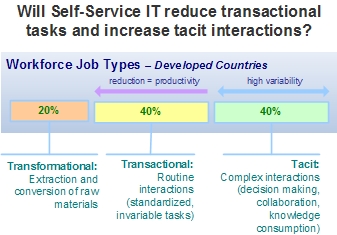Leveraging Web 2.0 for business growth

I was in San Francisco last week at JavaOne at the same time that Gartner's IT/Symposium was taking place, though I was unable to attend Gartner's event. I was however on a JavaOne panel that discussed Ajax, SOA, and Web 2.0, the convergence of the latter two in particular which is a topic of special interest to me. The organizations that can effectively add enterprise context to this and make it work successfully for them will be able to develop a sustainable competitive advantage.The packed room of 1,200 people that came to hear the panel, overlaid with Gartner's pronouncement a few days ago that Web 2.0 offers enterprises many opportunities for growth, underscored an important point for me.
Namely that IT management and IT workers seem to have a major opportunity to align together. To be sure, many folks at the panel came to hear about Ajax and not Web 2.0, yet a clear majority of the audience also raised their hands about both Web 2.0 and SOA when asked why they came. And most of these folks were programmers that for the most part were not tracking Web 2.0 last year.
Call it Enterprise 2.0 or what have you, there now seems to be a lot of shared, common attention to these ideas right now across the ranks of IT.
But other than the buzzword factor, what does Web 2.0 bring to the table as far as real business value? It's this question in particular we're continuing to circle as we continue looking at Web 2.0 strategies in the enterprise.
Read Part 1, Part 2, Part 3, Part 4 of our exploration of Web 2.0 strategies in the enterprise.
I covered BPM strategies for Web 2.0 in my last post and pointed to a few companies that best exhibited the advantages that lightweight, Web-based, self-service BPM can provide. You may recall that one of the key concepts of Web 2.0 (diagram) is The Long Tail, which describes the mass servicing of micromarkets, which is only possible (or at least, cost-effective) in a self-service world.
Thus, giving employees the tools to create and continuously tweak automated business processes themselves has enormous potential because of what it enables: the emergent reduction of routine, low-value transactional work and an increase in tacit interactions.
Read about the Sandhill Report on the software outlook for 2006 and its emphasis on leveraging Web 2.0 and tacit interactions.
And it's here that it gets interesting. That's because the latest round of low-barrier, easily-changed, mashup-style BPM tools let users focus on developing solutions that assist users in automating and managing either transactional or tacit interactions. In this way, automating tedious and manual transactions can increase the time spent on tacit interactions. Some experts claim this is approach can provide access to the last bastion of work productivity productivity. But spending that same time focusing on building solutions that support and enable tacit interactions might have even more return on investment.
Tacit interactions, however, are generally harder to automate because of their variability and open-endedness. In general, they are largely guided by skilled workers, and it's this part that Web 2.0 techniques might be able to help address most by getting excessive central control out of their way. I find mashup tools fascinating for just this reason; because they point to a near-term future where most skilled end-users can find or build/tweak just the right solution, just when they need it. This is a sort of Hypercard effect, so that when an existing mashup is almost right, the user can "clone" it and add the last couple of features or data sources needed to make it serviceable for a new task.

As I've written about in the past, companies such as Intalio have been developing this vision, which they call BPM 2.0, and the idea at least shows the potential for what Gartner and McKinsey have been talking about: Leveraging network effects, self-service IT, and the recombinant Web to harness new growth and productivity gains in the enterprise. Note: I've recently taken Intalio's BPM 2.0 tools for a spin and have been impressed so far, hopefully I'll do a tour of this in a future post.
Given this, here is a rough take on using Web 2.0 for BPM and self-service business process automation:
Applying Web 2.0 Concepts to BPM
- Low-barrier, available anywhere, Web-based business process mashups (Ajax and RIAs with granular URL structures)
- Allow business users to structure business information and content (folksonomies over taxonomies)
- Continuous, bottom-up management and maintenance of business processes by the end-users that use them
- Business processes exposed as Web services, turning the business process into a reusable platform
- Easy inclusion of external Web-friendly data sources and services into business processes
- Based on portable, recognized standards as much as possible (OpenAjax, RSS, REST, SOAP, BPEL, etc.)
- Web 2.0-style collaboration (wiki-style editing, blog-style publishing, social networking, etc.)
And lest we forget, the advantage of applying the successful techniques we observe out on the Web is due to the strong Darwinian forces at work on such a large stage. The organizations that can effectively add enterprise context to this and make it work successfully for them will be able to develop a sustainable competitive advantage. In fact, notwithstanding the continued reports of people like Nick Carr, McKinsey and Company's latest article on tacit interactions highlights an important comparison of similar organizations that shows a surprisingly wide interaction variability between them. This indicates that "there is considerable competitive headroom for improving productivity." This could mean that IT still matters, if it can demonstrate that it still matters, that is.
What do you think? Will BPM get a second life with techniques that make it responsive and user-controlled enough to tap real growth potential and productivity gains?